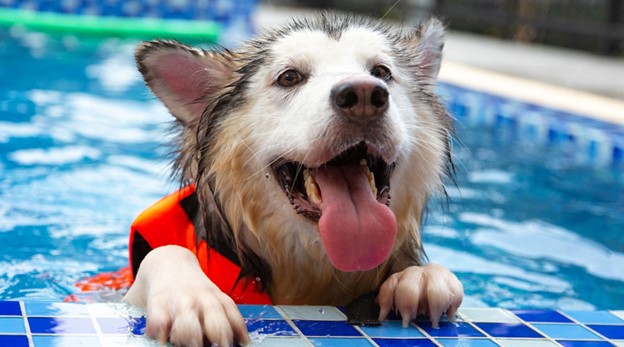Water Safety 101: Protecting your dogs this summer
Swimming is great exercise for those dogs who love it, but even the most water-ready of retrievers can get into trouble without their families looking out for them. Whether you’re heading to the pool, the beach or the lake, there are a few cautions to consider before jumping in.
Overall concerns
It’s essential to know your own dog and be aware of the hazards wherever you’re heading. Don’t force any dog into the water.
Body type: Some “top-heavy” breeds such as the English bulldog are at higher risk for drowning, and shouldn’t be around water at all without a canine personal floatation device (PFD) and you nearby or beside them in the water, watching closely.
Age and health: Puppies, older dogs and impaired dogs – even those from water-loving breeds or mixes – may overestimate their swimming abilities and get themselves into trouble quickly. Canine PFDs allow tired dogs to take a slight breather and float, but don’t take chances: Keep an eye on your dog.
Overheating: Avoid swimming during the hottest part of the day to prevent heat exhaustion. Bring fresh water for your dog to drink and offer it frequently. Watch for signs of overheating such as rapid panting, and get help sooner rather than later.
Local wildlife: It’s not uncommon for dead fish or wildlife to wash up on the shore of natural bodies of water. Various live animals, such as jellyfish, snakes and other reptiles, can also be dangerous. Again, don’t allow your pet to have access to anything hazardous, even if you have to pack up and go home.
Drowning/near drowning: Pets who venture out too far are at risk of drowning. If your pet goes under the water and you suspect they’ve inhaled any, get them medical attention immediately. Even if you think they’re okay, if they get water into their lungs, it can lead to problems even days later, which can be fatal.
Drinking unsafe water: If you spot your dog drinking water from the pool, lake or ocean, it’s time to call it a day. Pool water contains chemicals that can be toxic to pets, lakes can contain deadly bacteria and ocean saltwater makes pets dehydrated and thirstier.
It’s always a good idea when away from home to know where the nearest veterinary practice is, and the days and hours of operation, along with information on emergency after-hours care.
Swimming pools

Teach your dog how to get out of the pool by encouraging them to swim to the steps or swim out from different areas. If your pool has a ladder, install a safety ramp to help pets (and wildlife who may fall in) to crawl out to safety.
Ponds and lakes

Warm summer days encourage the growth of blue-green algae in lakes and ponds. The substance isn’t “algae” at all but rather clumps of toxic cyanobacteria. Dogs ingesting cyanobacteria may show symptoms – including vomiting, diarrhea, drooling, weakness, confusion or collapse – within less than 30 minutes, and death may follow before – and even with – prompt veterinary attention.
Don’t take a chance. Do not allow your dog to swim in non-flowing bodies of water when signs of pond scum, algae or algae-like vegetation is present. The U.S. Environmental Protection Agency maintains a web page with links to cyanobacteria monitoring by state that’s worth checking out. If exposed, your dog needs to be rinsed off thoroughly in clean water and taken to the nearest veterinary hospital.
Rivers and streams

Free-flowing water may seem cleaner than that found in lakes or ponds, but these options, too, may be dangerous. Check with local agencies to be sure the water is safe before letting your dog dive in.
Problems can include upstream contamination, cold water from late snow melt, unseen underwater hazards such as rocks, logs or branches, and swift-flowing currents. If the water is safe, look for clean, shallow areas and keep fetch games out of deeper, faster water.
Oceans and seas

Many communities have designated “dog beaches” to allow canine access to water without causing problems with human beachgoers. Even in designated areas, though, check with local authorities on current conditions – make sure they’re safe before you head out.
Watch for dangerous currents and riptides, avoid visits during the hottest part of the day, and keep fresh drinking water on hand at all times. Don’t let your dog ingest sand or salt water (which can lead to stomach upset), swim too far out, chase marine mammals, or bother jellyfish or crabs.
Summer wouldn’t be the same without swimming, but you can take necessary precautions to keep your dog safe. Happy swimming!
Be pup-pared for summer with Nationwide pet insurance: It’s like sunscreen for veterinary bills
Dogs are more likely to bring home an ear infection from a beach day than a jellyfish sting. Let’s say your dog’s beach day ended with tender ears. Here’s how a Nationwide pet insurance plan would help.1
- Your vet (or any licensed veterinarian) treats .
- You pay the invoice of $3022
- You submit a photo of your paid invoice
- Nationwide reimburses your eligible expenses
Assuming you selected our most popular 80% plan and have met your annual deductible, you’d be reimbursed for $242,1 and get peace of mind knowing that is going to be okay.
Get a pet insurance quote today https://partnersolutions.nationwide.com/premier-landing/iafffc?utm_source=IAFF&utm_medium=email&utm_campaign=custom&utm_content=Summer
[1] Some exclusions may apply. Certain coverages may be excluded due to pre-existing conditions. See policy documents for a complete list of exclusions. Plans may not be available in all states. Policy eligibility may vary. All plans require accident coverage; additional coverage for illness, hereditary & congenital, and wellness is optional. Optional coverage for behavior, prescription food and prescription supplements may also be available. Optional cruciate coverage may be added after the first year of coverage; not available in all states. Pre-existing conditions are not covered. [2] Based on Nationwide claims data for canine ear infection treatment. Estimated treatment cost includes expenses incurred in the first 30 days after initial diagnosis.
Insurance products underwritten by Veterinary Pet Insurance Company (CA), Columbus, OH; National Casualty Company (all other states), Columbus, OH. Agency of Record: DVM Insurance Agency. All are subsidiaries of Nationwide Mutual Insurance Company. Subject to underwriting guidelines, review and approval. Products and discounts not available to all persons in all states. Insurance terms, definitions and explanations are intended for informational purposes only and do not in any way replace or modify the definitions and information contained in individual insurance contracts, policies or declaration pages, which are controlling. Nationwide, the Nationwide N and Eagle, and Nationwide is on your side are service marks of Nationwide Mutual Insurance Company. ©2025 Nationwide. 25CRS10425B.
